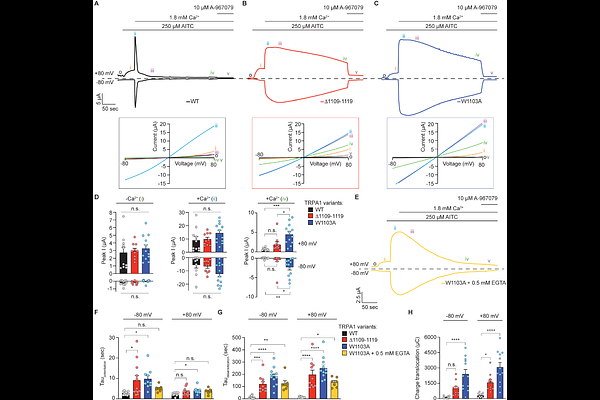Calmodulin binding is required for calcium mediated TRPA1 desensitization

Calmodulin binding is required for calcium mediated TRPA1 desensitization
Sanders, J. H.; Taiwo, K. M.; Adekanye, G. A.; Bali, A. P.; Zhang, Y.; Paulsen, C. E.
AbstractCalcium (Ca2+) ions affect nearly all aspects of biology. Excessive Ca2+ entry is cytotoxic and Ca2+-mobilizing receptors have evolved diverse mechanisms for tight regulation that often include Calmodulin (CaM). TRPA1, an essential Ca2+-permeable ion channel involved in pain signaling and inflammation, exhibits complex Ca2+ regulation with initial channel potentiation followed by rapid desensitization. The molecular mechanisms of TRPA1 Ca2+ regulation and whether CaM plays a role remain elusive. We find that TRPA1 binds CaM best at basal Ca2+ concentration, that they co-localize in resting cells, and that CaM suppresses TRPA1 activity. Combining biochemical, biophysical, modeling, NMR spectroscopy, and functional approaches, we identify an evolutionarily conserved, high-affinity CaM binding element in the distal TRPA1 C-terminus (DCTCaMBE). Genetic or biochemical perturbation of Ca2+/CaM binding to the TRPA1 DCTCaMBE yields hyperactive channels that exhibit drastic slowing of desensitization with no effect on potentiation. Ca2+/CaM TRPA1 regulation does not require the N-lobe, raising the possibility that CaM is not the Ca2+ sensor, per se. Higher extracellular Ca2+ can partially rescue slowed desensitization suggesting Ca2+/CaM binding to the TRPA1 DCTCaMBE primes an intrinsic TRPA1 Ca2+ binding site that, upon binding Ca2+, triggers rapid desensitization. Collectively, our results identify a critical regulatory element in an unstructured TRPA1 region highlighting the importance of these domains, they reveal Ca2+/CaM is an essential TRPA1 auxiliary subunit required for rapid desensitization that establishes proper channel function with implications for all future TRPA1 work, and they uncover a mechanism for receptor regulation by Ca2+/CaM that expands the scope of CaM biology.